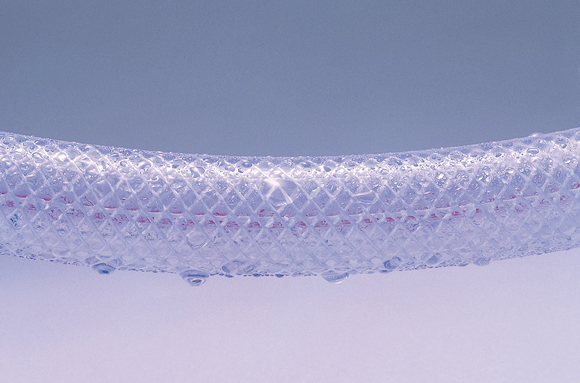Hose and Coupling Knowledge Base
If You Register to Become a Web Member, We Will Send You the Latest Information on Hoses and Coupling.
The Dangers of Hose Condensation

In the heat of summer, when you leave a cold drink on the table, beads of water form on the outside.
This phenomenon is called condensation, and is also seen on cooling pipes in factories. When moisture in the air comes into contact with a hose or pipe carrying a cold fluid, that moisture condenses back into water. That water can lead to accidents.
For example, condensation on a pipe can drip onto the floor, creating a slipping hazard. The water can also get into the electrical systems of machines and potentially cause a short or fire.

Keeping the difference between the hose and ambient temperature to a minimum will reduce condensation, but the cost of air conditioning to do so can be very expensive. To prevent condensation, polyethylene foam insulation is generally used to wrap hoses and pipes.
The key issue when doing so is to make sure the foam is up against the hose, and to cover the connecting parts. Because couplings are made of metal, they have a tendency to attract even more condensation than hoses. Because the coupling portion changes in size, care is needed to make sure the foam fully covers the coupling, leaving no gaps.
Toyox sells hoses already covered in insulation, as well as insulating coupling covers that leave no gaps. We invite you to try them.
Archive
How to Cut Steel-Wire-Reinforced PVC Hose
Does Electricity Conservation Increase Condensation?
Why Do Hoses Leak & Disconnect?
Can PVC & Other Plastic Hoses Be Used for Fuel Gas & Kerosene?
How to Read Catalog Specifications, Part 4 – Are Hose Sizes Random?
How to Read Catalog Specifications, Part 3 – Minimum Bend Radius
Beware of Static Electricity on Hoses
How to Read Catalog Specifications, Part 2 – Negative Pressure+B10
About REACH, RoHS, Endocrine Disruptor & the Food Sanitation Act
How to Read Catalog Specifications, Part 1 – Use Pressure
How to Avoid Damage Caused by Ultraviolet Rays
The Dangers of Hose Condensation
Why Transparent Hoses Become Cloudy
Leaks & Disconnections Due to Mismatched Couplings & Hoses
Causes & Solutions for Leaks & Disconnections
The Benefits of the Right Hose for the Situation (2)









